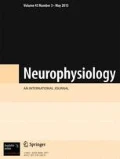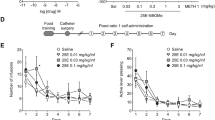We investigated the effects of silymarin, a component of the extract from milk thistle (Silybum marianum) on the level of anxiety in rats and also the potential role of the serotonergic system in the modulatory influences of silymarin on anxiety-related behavior. The elevated plus-maze test was used for testing the above level. Oral administrations of silymarin (35, 70, 140, and 280 mg per rat) for 2 weeks induced an anxiolytic-like effect shown by specific increases in normalized values of the open arm time (OAT) and open arm entries (OAE) in the elevated plus-maze. Intraventricular infusion of a 5-HT1A receptor agonist, 8-OH-DPAT (5, 10, and 25 ng per rat), increased the OAT and OAE, indicating that this agent also possesses an anxiolytic effect. Similar injections of a 5-HT1A receptor antagonist, NAN190 (0.25, 0.5, and 1.0 μg per rat), intensified anxiety-related behavior. The least effective dose of intraventricularly injected 8-OH-DPAT (5 ng per rat), when co-administered with silymarin (35, 70, and 140 mg per rat, pretreatment for 2 weeks), decreased the anxiety-related behavior significantly. An effective dose of NAN190 (0.5 μg per rat) combined with silymarin in the above-mentioned dosage provided significant decreases in the OAT and OAE. These results demonstrate that the effects of silymarin on anxiety are mediated, at least partly, by 5-HT1A receptors of serotonin.
Similar content being viewed by others
References
R. Krueger, “The structure of common mental disorders,” Arch. Gen. Psychiat., 56, No. 10, 921-926 (1999).
H. Wittchen and J. Hoyer, “Generalized anxiety disorder: nature and course,” J. Clin. Psychiat., 62, Suppl. 11, 15-21 (2001).
R. Kessler, J. Soukup, R. Davis, et al., “The use of complementary and alternative therapies to treat anxiety and depression in the United States,” Am. J. Psychiat., 158, 289-294 (2001).
D. Eisenberg, R. Davis, S. Ettner, et al., “Trends in alternative medicine use in the United States, 1990-1997: results of a follow-up national survey,” Jama, 280, No. 18, 1569-1575 (1998).
J. Astin, “Why patients use alternative medicine: results of a national study,” Jama, 279, No. 19, 1548-1553 (1998).
L. Seeff, K. Lindsay, B. Bacon, et al., “Complementary and alternative medicine in chronic liver disease,” Hepatology, 34, No. 3, 595-603 (2001).
S. Verma and P. Thuluvath, “Complementary and alternative medicine in hepatology: review of the evidence of efficacy,” Clin. Gastroenterol. Hepatol., 5, No. 4, 408-416 (2007).
T. Listings, From Wikipedia (View original Wikipedia Article). Last modified on 29 July, 2010, at 17: 49.
P. Lu, T. Mamiya, L. Lu, et al., “Silibinin attenuates cognitive deficits and decreases of dopamine and serotonin induced by repeated methamphetamine treatment,” Behav. Brain Res., 207, No. 2, 387-393 (2009).
R. Lanzenberger, M. Mitterhauser, C. Spindelegger, et al., “Reduced serotonin-1A receptor binding in social anxiety disorder,” Biol. Psychiat., 61, No. 9, 1081-1089 (2007).
R. Schreiber and J. De Vry, “5-HT1A receptor ligands in animal models of anxiety, impulsivity and depression: multiple mechanisms of action?” Prog. Neuro-Psychopharmacol. Biol. Psychiat., 17, No. 1, 87-104 (1993).
G. Paxinos and C. Watson, The Rat Brain in Stereotaxic Coordinates, Academic Press, San Diego (2007).
R. J. Rodgers and N. J. Johnson, “Factor analysis of spatiotemporal and ethological measures in the murine elevated plus-maze test of anxiety,” Pharmacol. Biochem. Behav., 52, No. 2, 297-303 (1995).
M. R. Zarrindast, J. Solati, S. Oryan, et al., “Effect of intra-amygdala injection of nicotine and GABA receptor agents on anxiety-like behaviour in rats,” Pharmacology, 82, No. 4, 276-284 (2008).
K. Thomas and P. Coleman, “Use of complementary or alternative medicine in a general population in Great Britain. Results from the National Omnibus survey,” J. Public Health, 26, No. 2, 152-157 (2004).
C. Lengacher, M. Bennett, K. Kip, et al., “Frequency of use of complementary and alternative medicine in women with breast cancer,” Oncology Nursing Forum, 29, No. 10, 1-9 (2002).
G. van der Watt, J. Laugharne, and A. Janca, “Complementary and alternative medicine in the treatment of anxiety and depression,” Curr. Opin. Psychiat., 21, No. 1, 37-42 (2008).
P. Barnes, E. Powell-Griner, K. McFann, et al., “Complementary and alternative medicine use among adults: United States, 2002,” Adv. Data, 27, 54-71 (2004).
E. Mazzio, N. Harris, and K. Soliman, “Food constituents attenuate monoamine oxidase activity and peroxide levels in C6 astrocyte cells,” Planta Med., 64, No. 7, 603-606 (1998).
M. Osuchowski, V. Johnson, Q. He, et al., “Alterations in regional brain neurotransmitters by silymarin, a natural antioxidant flavonoid mixture, in BALB/c mice,” Pharmaceutical Biol., 42, Nos. 4/5, 384-389 (2004).
E. Akimova, R. Lanzenberger, and S. Kasper, “The serotonin-1A receptor in anxiety disorders,” Biol. Psychiat., 66, No. 7, 627-635 (2009).
H. Goldberg and R. Finnerty, “The comparative efficacy of buspirone and diazepam in the treatment of anxiety,” Am. J. Psychiat., 136, 1184-1187 (1979).
R. Gammans, J. Stringfellow, A. Hvizdos, et al., “Use of buspirone in patients with generalized anxiety disorder and coexisting depressive symptoms,” Neuropsychobiology, 25, No. 4, 193-201 (1992).
F. Artigas, L. Romero, C. de Montigny, et al., “Acceleration of the effect of selected antidepressant drugs in major depression by 5-HT1A antagonists,” Trends Neurosci., 19, No. 9, 378-383 (1996).
L. Heisler, H. Chu, T. Brennan, et al., “Elevated anxiety and antidepressant-like responses in serotonin 5-HT1A receptor mutant mice,” Proc. Natl. Acad. Sci. USA, 95, 15049-15054 (1998).
I. Belcheva, S. Belcheva, V. Petkov, et al., “Behavorial responses to the 5-HT1A receptor antagonist NAN190 injected into rat CA1 hippocampal area,” Gen. Pharmacol., 28, No. 3, 435-441 (1997).
S. File, L. Gonzalez, and N. Andrews, “Comparative study of pre- and postsynaptic 5-HT1A receptor modulation of anxiety in two ethological animal tests,” J. Neurosci., 16, No. 15, 4810-4815 (1996).
G. Kennett, M. Marcou, C. Dourish, et al., “Single administration of 5-HT1A agonists decreases 5-HT1A presynaptic, but not postsynaptic receptor-mediated responses: relationship to antidepressant-like action,” Eur. J. Pharmacol., 138, No. 1, 53-60 (1987).
T. Jolas, R. Schreiber, A. Laporte, et al., “Are postsynaptic 5-HT1A receptors involved in the anxiolytic effects of 5-HT1A receptor agonists and in their inhibitory effects on the firing of serotonergic neurons in the rat?” J. Pharmacol. Exp. Ther., 272, No. 2, 920-929 (1995).
P. Chua, M. Krams, I. Toni, et al., “A functional anatomy of anticipatory anxiety,” NeuroImage, 9, 563-571 (1999).
J. Kazer and A. Sharkey, “The septo-hippocampal system and anxiety: A robot simulation,” in: ICANN99 Ninth International Conference on Artificial Neural Networks (7-10 September, 1999), Vol. 1, Univ. of Edinburg, UK (1999), pp. 389-394.
M. Davis, “The role of the amygdala in fear and anxiety,” Ann. Rev. Neurosci., 15, 353-375 (1992).
Author information
Authors and Affiliations
Corresponding author
Rights and permissions
About this article
Cite this article
Solati, J., Yaghmaei, P. & Mohammdadi, K. Role of the 5-HT1A Serotonergic System in Anxiolytic-Like Effects of Silymarin. Neurophysiology 44, 49–55 (2012). https://doi.org/10.1007/s11062-012-9266-0
Received:
Published:
Issue Date:
DOI: https://doi.org/10.1007/s11062-012-9266-0




